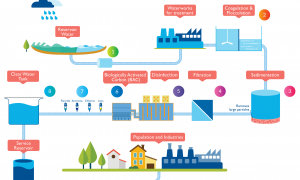🕑 Reading time: 1 minute
There are different types of hydro power plants based on types of facilities for generation of hydropower. We will discuss about these hydropower plants.
Construction of large hydropower plants is practical and economically viable proposition as the capital costs of a project can be reduced with such installations.
With the growth of power systems, there has been increase in the need for peak load capability of hydropower plants. In some power plant systems, the ratio of power demands at peak periods and off-peak periods has also become greater. The use of reversible pump turbines is one of the method by which the growing demands for economical peak power is being met.
The evolution of the bulb turbines or pump turbines has helped in greater economy in the development of low-head river and tidal power projects.
Contents:
Different types of modern hydro power plants:
1. Pumped storage hydropower plants
2. Reversible turbine pump hydropower plants
3. Underground hydropower plants
4. Tidal power plants
Pumped Storage Hydropower Plants:
To supply the peak loads, hydropower plants has to have the installed capacity of high loads of which remains idle during the off-peak hours. The more the demands of variable power supply, it is necessary to devise some way to achieve the economical loading of the power plant by levelling up the load curve. The following are some of the ways:
(a) Commercial Method: To sell electric current at a higher rate during peak hours than during off-peak hours.
(b) Technical method: The following are the two methods:
(i) By installing special peak load power plants
(ii) By storing energy produced during off-peak hours. Such a system is known as Pumped Storage Plants.
Purpose of Pumped Storage Hydropower Plants:
This type of plants combined with steam power stations reduces the power load fluctuations to narrow limits. In some cases, the storage plant consists of pump and motor with no turbines. The pump increases the head in the feeder reservoir of a separate hydro-electric plant while motor improves the power factor in the electric supply network.
Combined with hydro-electric power plants, it can take charge of daily peak load and seasonal variations of water.

Types of Pumped Storage Plants:
- Daily, weekly or seasonal storage plants
- High, medium or low head plants
- According to the type of turbine used in the plant
- Pure or mixed storage hydropower plants
- Horizontal or vertical storage plants
Reversible Turbine Hydro Power Plants:
In this type of hydropower plants, Francis turbines which are just a reverse of centrifugal pump functions in one direction as a motor driven pump and in the reverse direction as turbine.
The efficiencies of pumping and generating processes have been found to exceed 65%. As the specific speed of a pump is greater than that of a geometrically similar turbines, two different rotational speeds are necessary for the two machines, if the best efficiency is to be obtained in each direction of rotation. The same speed is possibly only with some sacrifice of efficiency.

Underground Hydropower Plants:
The underground hydropower plants are constructed below the upper level of water. These are low head plants. This type of installation consists of a weir across the river to be harnessed and housing the power plants within the weir.
The head race is connected to the tail race by a straight passage in which the tubular or bulb turbines operate. The turbine is connected to the generator by a horizontal or an inclined shaft depending on convenience.

The advantages of underground hydropower plants are:
- They are safe against any attacks by enemies or terrorists, rock and earth slips and snow avalanches.
- Air-conditioning is possible throughout the year.
- They show greater operating heads.
- Since excavation is in rocks, considerable savings in the cost of power plant construction and erection of accessories are possible.
- They do not affect the scenic beauty of the site.
Tidal Power Plants:
Tidal power plants are not considered as a hydropower plant. The discharge and head are made available due to the tide. This is due to rotation of earth.
Tides flood vast areas and raise the sea level along the seashores by amounts varying from a few centimeters to several meters. A tremendous amount of energy is stored in the earth in this process. The force exerted by tides is such as to slow down the earth's rotation.
(Image Source https:// technologystudent .com/energy1/tidal1.htm)
Tidal energy can be increased by artificial arrangements, such as:
- If the gates connecting the tidal basin with the sea are suddenly opened at high water, the tidal wave rapidly begins to raise the basin level. After reflection, the filling wave returns to the dam, its crest being above the initial sea level. If the gates can be quickly closed exactly at this instant, the plant can operate during the ebb under an additional head created by reflection of this flood wave.
- Pumping into the basin from the sea at high water and from the basin into the sea at low water is also another method of proper utilization of tidal power.
Advantages of Tidal Power Plants:
- To compensate the failure of hydro-power plants
- To provide constant power supply
- To improve the efficiency of entire power generating system
- To operate the atomic and thermal power plants under most economical conditions.
- These are cheaper than thermal or hydropower plants.



